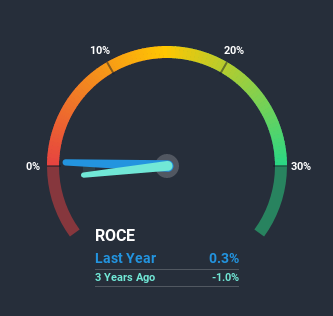Does R.E.A. Holdings' (LON:RE.) Returns On Capital Reflect Well On The Business?

If we're looking to avoid a business that is in decline, what are the trends that can warn us ahead of time? A business that's potentially in decline often shows two trends, a return on capital employed (ROCE) that's declining, and a base of capital employed that's also declining. Ultimately this means that the company is earning less per dollar invested and on top of that, it's shrinking its base of capital employed. Having said that, after a brief look, R.E.A. Holdings (LON:RE.) we aren't filled with optimism, but let's investigate further.
Understanding Return On Capital Employed (ROCE)
Just to clarify if you're unsure, ROCE is a metric for evaluating how much pre-tax income (in percentage terms) a company earns on the capital invested in its business. Analysts use this formula to calculate it for R.E.A. Holdings:
Return on Capital Employed = Earnings Before Interest and Tax (EBIT) ÷ (Total Assets - Current Liabilities)
0.0034 = US$1.7m ÷ (US$581m - US$76m) (Based on the trailing twelve months to June 2020).
Thus, R.E.A. Holdings has an ROCE of 0.3%. Ultimately, that's a low return and it under-performs the Food industry average of 9.4%.
Check out our latest analysis for R.E.A. Holdings
While the past is not representative of the future, it can be helpful to know how a company has performed historically, which is why we have this chart above. If you'd like to look at how R.E.A. Holdings has performed in the past in other metrics, you can view this free graph of past earnings, revenue and cash flow.
What Can We Tell From R.E.A. Holdings' ROCE Trend?
We are a bit worried about the trend of returns on capital at R.E.A. Holdings. About five years ago, returns on capital were 0.9%, however they're now substantially lower than that as we saw above. Meanwhile, capital employed in the business has stayed roughly the flat over the period. Companies that exhibit these attributes tend to not be shrinking, but they can be mature and facing pressure on their margins from competition. So because these trends aren't typically conducive to creating a multi-bagger, we wouldn't hold our breath on R.E.A. Holdings becoming one if things continue as they have.
What We Can Learn From R.E.A. Holdings' ROCE
In summary, it's unfortunate that R.E.A. Holdings is generating lower returns from the same amount of capital. Unsurprisingly then, the stock has dived 78% over the last five years, so investors are recognizing these changes and don't like the company's prospects. With underlying trends that aren't great in these areas, we'd consider looking elsewhere.
If you'd like to know more about R.E.A. Holdings, we've spotted 3 warning signs, and 1 of them is significant.
For those who like to invest in solid companies, check out this free list of companies with solid balance sheets and high returns on equity.
This article by Simply Wall St is general in nature. It does not constitute a recommendation to buy or sell any stock, and does not take account of your objectives, or your financial situation. We aim to bring you long-term focused analysis driven by fundamental data. Note that our analysis may not factor in the latest price-sensitive company announcements or qualitative material. Simply Wall St has no position in any stocks mentioned.
Have feedback on this article? Concerned about the content? Get in touch with us directly. Alternatively, email editorial-team@simplywallst.com.


